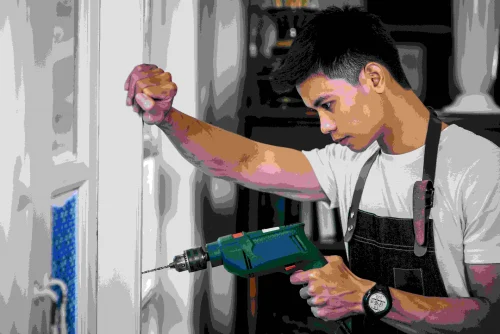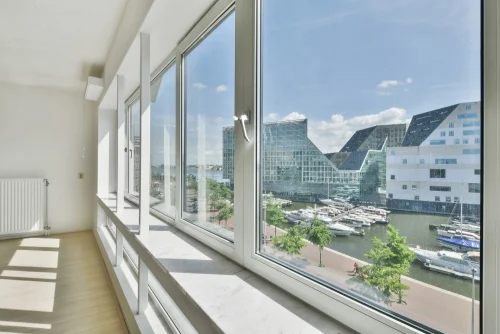
Limewash Wall Finishes in India: Timeless Texture for Modern Indian Homes
July 25, 2025
Top 10 Must-Have uPVC French Windows for Stylish & Smart Indian Homes
July 28, 2025You walk into your home on a summer afternoon, expecting some cool relief from the scorching heat outside. But instead, your house feels almost as warm as the outdoors. The air conditioner is working, but the room refuses to cool down. In winter, the situation reverses. You turn on the heater, but the room never feels completely warm. The problem? Often, it's your windows.
Windows are one of the biggest contributors to heat loss and gain in a home. The right glazing not only improves comfort but can also save you significant money on energy bills, reduce noise, and protect your home from moisture problems.
Table of contents
- What is Glazing in uPVC Windows?
- Challenges in Indoor Temperature
- How Does Thermal Insulation Work in Glazing?
- Which Glazing is Ideal for the Indian Climate?
- What About Noise Reduction?
- Cost of Double Glazing
- Significance of Single Glazing
- Conclusion
- GreenFortune - Your Premium Solution for uPVC Windows and Doors
- FAQs
What is Glazing in uPVC Windows?
Glazing refers to the glass portion of your window. While the frame holds everything in place, it’s the glazing that provides insulation, noise control, and protection from the weather.
UPVC, which stands for unplasticized polyvinyl chloride, has become a popular choice for window frames. It is durable, easy to maintain, weather-resistant, and energy efficient. But even with a strong uPVC frame, the type of glazing you choose will decide how well your window performs.
There are mainly two types of glazing options available:
- Single Glazing: Only one pane of glass is installed. This creates a single barrier between the inside and outside.
- Double Glazing: Two panes of glass are used, separated by a small gap that is often filled with air or inert gas. This gap works as an insulating layer, making double glazing much better at controlling temperature and noise.
Challenges in Indoor Temperature
One of the biggest challenges Indian homeowners face is maintaining a comfortable indoor temperature throughout the year. In summer, heat quickly enters through single-glazed windows, making your air conditioning work harder. In winter, whatever heat your room gains from a heater or sunlight escapes easily through the same windows. This constant struggle leads to higher electricity bills and uncomfortable living conditions.
This is where double glazing offers a clear solution. Thanks to its additional glass layer and insulating gap, double glazing offers superior thermal insulation, keeping your indoor temperature stable throughout the year. The result is a home that stays cooler in summer and warmer in winter, with much lower energy consumption.
How Does Thermal Insulation Work in Glazing?
Thermal insulation means stopping heat from easily passing through a material. Plain glass doesn't do this well, which is why windows with just one glass pane let heat in and out easily.
Double glazing solves this by putting two glass panes together with a small gap in between. This gap is filled with air or a special gas like argon, which helps block heat. It works like a shield, keeping outside heat out in summer and stopping indoor warmth from escaping in winter.
For instance, in hot places like Jaipur or Ahmedabad, where the temperature can go above 45°C, double-glazed windows help keep your home cooler. And in cold places like Shimla or Manali, they keep the warmth inside, so your heater doesn’t have to work as hard.
Read more - Why Choose uPVC Windows and Doors for Monsoon
Which Glazing is Ideal for the Indian Climate?
India has a wide range of climates, from extreme heat to intense cold, from coastal humidity to moderate weather zones. This variety makes it essential to choose glazing that suits your specific region.
In hot and dry areas such as Rajasthan, Delhi NCR, and parts of Gujarat, double glazing is highly recommended. These regions experience extremely high temperatures, and double glazing can prevent heat buildup inside homes, reducing the workload on air conditioners.
In cold and hilly areas like Himachal Pradesh, Uttarakhand, and Jammu & Kashmir, double glazing helps retain indoor warmth during long, cold winters. This results in lower heating costs and a much more comfortable living environment.
In coastal and humid areas like Mumbai, Chennai, and Kerala, the main concern is not extreme heat or cold but condensation control. Moist air often condenses on window surfaces, creating water droplets that can damage paint, lead to mould growth, and even ruin furniture. Double glazing helps manage this problem by keeping the inside glass pane closer to room temperature, which reduces condensation.
What About Noise Reduction?
Another big difference between single glazing vs double glazing is noise control. As Indian cities become more crowded, noise pollution is now a common complaint. Whether it’s traffic, construction, or loud neighbours, external noise can make your home less peaceful.
Single-glazed windows provide little protection from outside noise. The thin glass allows sound waves to pass through easily. Double-glazed windows, however, create a strong barrier that reduces noise levels dramatically.
Here is a differentiation table for your reference -
Feature | Single Glazing | Double Glazing |
Glass Structure | One pane of glass | Two panes of glass with an air/inert gas gap |
Thermal Insulation | Poor – allows easy heat transfer | Excellent significantly reduces heat gain/loss |
Energy Efficiency | Low increases energy consumption for cooling/heating | High-lowers electricity bills by maintaining stable temperatures |
Noise Reduction | Minimal – lets in outside noise | Very Good blocks out most external noise |
Condensation Control | Prone to condensation, especially in humid areas | Reduces condensation by keeping the inner glass warmer |
Ideal for Climate | Mild, moderate, or temporary structures | Extreme heat, cold, or high humidity zones (most Indian cities) |
Comfort Level | Lower indoor temperatures fluctuate | Higher – indoor environment remains stable year-round |
Initial Cost | Lower upfront cost | Higher initial investment |
Long-Term Cost | High – increased electricity bills and potential repairs | Lower energy savings and less maintenance |
Durability | Good, but less effective over time | Very durable – lasts 15–20+ years with minimal loss of performance |
Maintenance Needs | May require more frequent upkeep due to moisture issues | Low–uPVC and sealed units resist rust, rot, and condensation |
Best Used For | Storage sheds, garages, temporary housing, and low-budget projects | Permanent homes, urban apartments, and climate-sensitive regions |
Aesthetic Impact | Standard, minimal visual difference | Adds modern appeal and value to property |
Cost of Double Glazing
While single glazing saves money upfront, it leads to higher electricity bills over time. Your AC and heating systems will run more often, increasing your energy expenses. You may also face frequent maintenance issues, like moisture damage or noisy interiors, which add to long-term costs.
Double glazing, on the other hand, starts paying for itself from the moment it’s installed. Lower energy bills, fewer repairs, better comfort, and longer lifespan make it a smarter financial decision in the long run.
Lasting of Double Glazing
Both single and double-glazed uPVC windows are designed for long-term use, but double-glazing offers superior durability. With proper installation and care, double-glazed units can last 15 to 20 years or more without performance loss.
UPVC frames resist rust, rot, corrosion, and termites. They require minimal maintenance - just occasional cleaning with soapy water is usually enough to keep them looking good for years.
Significance of Single Glazing
Temporary structures, storage sheds, or garages may not need the advanced benefits of double glazing. If your budget is very tight or you live in an area with very mild weather throughout the year, single glazing could serve your needs for basic protection.
However, for most permanent homes in India, especially in regions with extreme temperatures or humidity, double glazing offers clear long-term advantages.
Read more - Guide to uPVC Arch Windows for Style and Comfort
Conclusion
Choosing between single glazing vs double glazing in uPVC windows is not just about how the windows look or what fits your immediate budget. Double glazing offers superior thermal insulation, helps with condensation control, reduces outdoor noise, and cuts electricity bills significantly.
If you're building or renovating your home, investing in double glazing is a smart decision that provides long-lasting comfort, safety, and value.
GreenFortune - Your Premium Solution for uPVC Windows and Doors
GreenFortune is your go-to partner for high-quality uPVC windows and doors designed with energy efficiency in mind. They offer lasting durability, comfort, and modern aesthetics to bring style into any home.
Whether you need replacement windows or are considering new construction, GreenFortune provides customized solutions that ensure exceptional value and long-term satisfaction for clients.
Choose GreenFortune today for innovative design and unmatched customer service. Get in touch with us now.
FAQs
- Is double glazing effective in coastal cities like Mumbai or Chennai?
Yes. Double glazing is highly effective in coastal areas. It helps manage humidity-related condensation control while also improving thermal comfort and reducing outside noise. - Can double glazing help reduce my energy bills?
Absolutely. Thanks to better thermal insulation, double glazing keeps your home cooler in summer and warmer in winter, reducing the load on your air conditioner and heater, which lowers electricity bills.
3. How long does double glazing last in Indian weather conditions?
With proper installation, double-glazed uPVC windows can easily last 15 to 20 years or more while maintaining performance and appearance, even under extreme Indian weather conditions.










